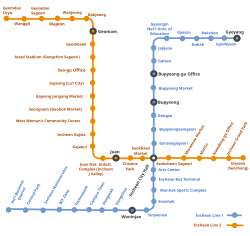Incheon Subway Line 1
 From Wikipedia the free encyclopedia
From Wikipedia the free encyclopedia
This article needs additional citations for verification. (December 2009) |
| Incheon Line 1 | |||
|---|---|---|---|
 | |||
| Overview | |||
| Native name | 인천 1호선(仁川一號線) Incheon Il Hoseon | ||
| Status | Operational | ||
| Termini | |||
| Stations | 30 | ||
| Service | |||
| Type | Rapid transit | ||
| System | Incheon Subway | ||
| Operator(s) | Incheon Transit Corporation | ||
| History | |||
| Opened | October 6, 1999[1] | ||
| Technical | |||
| Line length | 30.3 km (18.8 mi)[2] | ||
| Number of tracks | 2 | ||
| Electrification | 1,500 V DC overhead catenary | ||
| |||
Incheon Subway Line 1 is a 30.3-kilometer (18.8 mi) north-south subway line,[2] part of the Incheon Subway system. The line is also included as a part of the overall Seoul Metropolitan Subway network; Bupyeong Station has a free transfer with Seoul Subway Line 1, Gyeyang Station connects with the AREX Line which leads to Incheon International Airport and Seoul Station, Bupyeong-gu Office Station has a free transfer with Seoul Subway Line 7, and Woninjae Station has a free transfer with the Suin-Bundang Line.
Background
[edit]Incheon's Line 1 makes Incheon the fourth city in South Korea and fifth in the Korean Peninsula with a subway system, after Pyongyang, Seoul, Busan, and Daegu.
A trip along the line from Gyeyang in the north to the International Business District in the south takes approximately 57 minutes. From Bakchon station to the International Business District station, the line is underground.
History
[edit]- March 1999: Trial runs begin.
- October 6, 1999: The line opens from Bakchon to Dongmak, after six years of construction.
- December 7, 1999: A northern extension from Bakchon to Gyulhyeon opens.
- March 16, 2007: Another northern extension from Gyulhyeon to Gyeyang opens, connecting with the Airport Railroad
- June 1, 2009: A southern extension from Dongmak to International Business District opens.
- December 12, 2020: One stop extension to Songdo Moonlight Festival Park opens.
Future plans
[edit]A northward 3-station extension of the line is proposed to provide transportation to the developing Geomdan New City. Construction began in November 2020[3] and is expected to be completed no earlier than 2024.[4]
Rolling stock
[edit]The line uses 34 8-car trains. The first 25 trains were built between 1998 and 1999 by Daewoo Heavy Industries and Rotem, while the last 9 trains were built between 2007 and 2008 by Hyundai Rotem to provide trains following the extension of the line.
Stations
[edit]All stations are location in Incheon.
| Station Number | Station Name English | Station Name Hangul | Station Name Hanja | Transfer | Distance in km | Total Distance | Location | ||
|---|---|---|---|---|---|---|---|---|---|
I110 | Gyeyang | 계양 | 桂陽 | --- | 0.0 | ||||
I111 | Gyulhyeon | 귤현 | 橘峴 | 0.9 | 0.9 | ||||
I112 | Bakchon | 박촌 | 朴村 | 1.5 | 2.4 | ||||
I113 | Imhak | 임학 | 林鶴 | 1.1 | 3.5 | ||||
I114 | Gyesan | 계산 (경인여자대학교) | 桂山 | 1.1 | 4.6 | ||||
I115 | Gyeongin National University of Education | 경인교대입구 (상록호텔조리직업전문학교) | 京仁敎大入口 | 0.9 | 5.5 | ||||
I116 | Jakjeon | 작전 (인천세종병원) | 鵲田 | 0.9 | 6.4 | ||||
I117 | Galsan | 갈산 (경문실용전문학교) | 葛山 | 1.4 | 7.8 | ||||
I118 | Bupyeong-gu Office | 부평구청 (로이문화예술 실용전문학교) | 富平區廳 | 1.0 | 8.8 | ||||
I119 | Bupyeong Market | 부평시장 (한길안과의원) | 富平市場 | 1.1 | 9.9 | ||||
I120 | Bupyeong | 부평 (부평힘찬병원) | 富平 | 0.9 | 10.8 | ||||
I121 | Dongsu | 동수 | 東樹 | 0.9 | 11.7 | ||||
I122 | Bupyeongsamgeori | 부평삼거리 | 富平삼거리 | 1.1 | 12.8 | ||||
I123 | Ganseogogeori | 간석오거리 | 間石오거리 | 1.2 | 14.0 | ||||
I124 | Incheon City Hall | 인천시청역 | 仁川市廳 | 1.4 | 15.4 | ||||
I125 | Culture & Arts Center | 예술회관 (가천대 길병원) | 藝術會館 | 1.0 | 16.4 | ||||
I126 | Incheon Bus Terminal | 인천터미널 (푸른세상안과) | 仁川터미널 | 0.8 | 17.2 | ||||
I127 | Munhak Sports Complex | 문학경기장 (그랜드오스티엄웨딩컨벤션) | 文鶴競技場 | 0.8 | 18.0 | ||||
I128 | Seonhak | 선학 | 仙鶴 | 0.8 | 18.8 | ||||
I129 | Sinyeonsu | 신연수 (가천대학교 메디컬캠퍼스) | 新延壽 | 1.1 | 19.9 | ||||
I130 | Woninjae | 원인재 | 源仁齋 | 0.9 | 20.8 | ||||
I131 | Dongchun | 동춘 (스퀘어원) | 東春 | 1.1 | 21.9 | ||||
I132 | Dongmak | 동막 (저어새 생태학습관) | 東幕 | 1.0 | 22.9 | ||||
I133 | Campus Town | 캠퍼스타운 (연세대학교) | 大学成 | 1.6 | 24.5 | ||||
I134 | Technopark | 테크노파크 (현대프리미엄아울렛송도점) | 테크노파크 | 0.8 | 25.3 | ||||
I135 | BIT Zone | 지식정보단지 | 知識情報團地 | 1.4 | 26.7 | ||||
I136 | Incheon National University | 인천대입구 (송도컨벤시아) | 仁川大入口 | 1.0 | 27.7 | ||||
I137 | Central Park | 센트럴파크 (포스코건설) | 中央公園 | 0.9 | 28.6 | ||||
I138 | International Business District | 국제업무지구 (센트로드) | 國際業務地區 | 0.8 | 29.4 | ||||
I139 | Songdo Moonlight Festival Park | 송도달빛축제공원 | 松島달빛祝祭公園驛 | 0.9 | 30.3 | ||||
See also
[edit]References
[edit]- ^ "History". Incheon Transit Corporation. Archived from the original on 2015-09-24. Retrieved 2014-09-03.
- ^ a b "General information". Incheon Transit Corporation. Archived from the original on 2015-09-24. Retrieved 2015-04-24.
- ^ Archived at Ghostarchive and the Wayback Machine: "[인천] 인천지하철 1호선 검단 연장선 착공 / YTN". YouTube. 11 November 2020.
- ^ "인천 지하철 1호선 계양~검단신도시 연장 2024년 완공". 23 August 2017.
